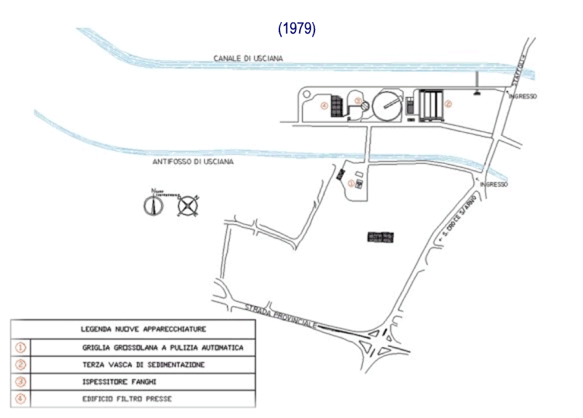The plant was designed for a maximum hydraulic capcity of 13.000 cubic meters per day, it worked from the end of August 1974 to January 1975 and occasionally until the end of April 1975. The supervision of the plant was assigned to Ditta Passavant which not only gave technical assitency, but also conducted experimental activities with the biological pilot plant.
On April 1975 the technical management felt under the control of municpal administration but, at the end of August 1975, it had been necessary to stop the plant activities because of problems related to disposal of sludge produced by the wastewater treatment process. The first plant, which became the nucleous of the following enlargements, was made of :
A) one grit for the wastewater enetering the homogenization step
B) one homogenization basin with a volume of 7.000 cubic meters
C) one rectangular tank for the chemical oxidation reaction
D) two sedimentation basins
E) one lifting station
F) one building including : offices, an internal analytical laboratory, a pump station, and the hygienic facilities
Here below, on the plant layout, the main part of the plant and the extension of the WWTP in 1974 are highlighted. In 1975 the first sludge thickener was built. Incoming wastewater flow rate was about 20.000 cubic meters per day, from monday to saturday. At that time, there wasn't any distinction between industrial and municipal wastewater due to the absence of two distinc sewer system, so these two type of wastewater were gathered in only one stream flow and treated as they arrived to the plant.
The plant treatment capacity was only 8.000 cubic meters and the untreated exceeding wastewater was discharged into the Antifosso channel, while the treated wastewater flew into the Usciana channel. The pollution degree of raw tannery wastewater was very high, with a COD (Chemical Oxygen Demand) value of about 6.000mgO2/L, and the treated flow stream still had about 1.700-1.800mgO2/L as COD.
Regione Toscana, with the law n. 22 of 22th May 1974, funded the construction of a sewer system for the collection and transfer of tannery wastewater from Fucecchio and Castelfranco di Sotto to the Santa Croce sull'Arno WWTP. Furthermore, the sludge treatment was also financed with the same law. The two new sewage flow rates were, repsectively, 5.000 cubic meters per day from Fucecchio and 2.000 cubic meters per day from Castelfranco di sotto.
It is important to note that, in 1974, the WWTP in Santa Croce sull'Arno was the only one tannery WWTP in Italy. According to this, there were not any other cases study for the evaluation of the treatment performances; so all research studies as well as the laboratory analyses provided until then, represented only useful hints but not reliable outcomes because of the lack of comparisons.
The Tuscan Leather District has always been characterized by an heterogeneous distribution of a large number of factories (ca. 300) as well as different production processes, these features affected the wastewater depuration, unable to ensure a continuous and regular treatment of raw sewage.
Thanks to the Regione Toscana financing support, Santa Croce sull'Arno municipality approved two different projects, one started on December 6th,1974 and the other on April 28th, 1975. Consequently, the following works took place:
a) First lot, 700.000.000 Lire. Sewer connection between Santa Croce sull'Arno WWTP, Fucecchio and Castelfranco di Sotto, for the treatment of the tannery wastewater (excluding the flow stream from Ponte a Cappiano), construction of a pump station and a storage tub for the raw sewage. Reorganisation of the main building and installation of new filter-press, hygienic services, locker rooms and water-closes.
b) Second lot, 800.000.000 Lire. Acquisition and start-up of a new filter-press (140 plates 1.500 x 1.500 mm) and its electro-mechanical equipments, for the dewatering of tannery sludge.
These works ended on June 1977. The Whole plant management costs were about 3.200.000.000. Lire in 1979 and it was entirely payed by tanners belonging to Consorzio Depuratore.
Even tough all these works contributed to improve plant performances, the purification issues were still hard and difficult to solve.
The scenario was very complex and many problems needed a solution yet, problems such as hydraulic issues, depuration of raw sewage and the last but not the least , treatment and disposal of sludge.
Hydraulic problems arose from the industrial sewer system, incomplete and capable to collect only a minor portion of industrial wastewater (40%), furthermore the existing collecting system showed problems related to the high solid content of industrial sewage.
Regarding to the treatment process issues, in those years only the first stage had been made. As a consequence of this, neither all incoming wastewater was treated, nor the requirements provided by Table C of Merli's law were achieved, even if the more restrictive limits of Table A were required.
Tannery sludge produced by the wastewater treatment plant was stored along 350 meters of a collecting channel between Santa Croce sull'Arno and Fucecchio. Despite of the first plant enlargement and the further installation of the first filter-press, sludge production still was a serious problem and so far from its solution. In fact, both the transport and the dispose of such a waste were very difficult because of the inefficient dewatering system which didn't allow to achieve the required threshold of 40-45% as solid substance. Two were the possible solutions: landfill disposal or incineration. At that time any other solution, including recycle, were excluded due to both the sludge characteristics and the lack of researches about a controlled landfill.
